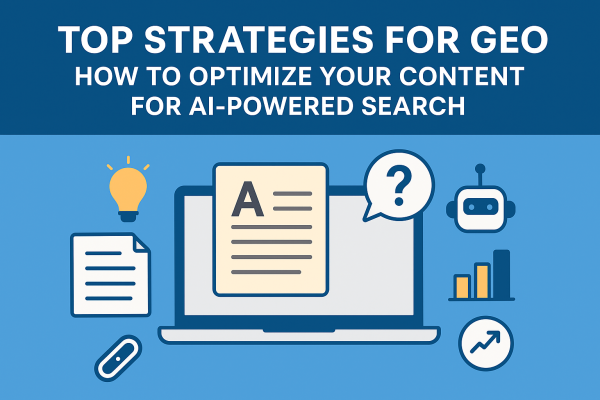Introduction
The era of Generative Engine Optimization (GEO) has arrived. Unlike traditional SEO, where visibility depended on Google’s ranking algorithm, GEO focuses on making your content attractive to generative AI systems such as ChatGPT, Gemini, Perplexity AI, and Claude.
These AI-driven search engines don’t just display a list of results; they synthesize knowledge from multiple sources into a single, conversational answer. That means the key to success is not just ranking—it’s being chosen and cited by AI.
In this article, we’ll explore the most effective GEO strategies you can apply today to future-proof your digital presence.
1. Structure Content for AI Readability
Generative models rely on structured, clear, and context-rich content. To increase the likelihood of being cited:
-
Use clear headings and subheadings (H2, H3, H4).
Example: Instead of one long block of text, break it into “What is GEO?”, “Why It Matters,” and “How to Apply It.” -
Bullet points and numbered lists.
These make information digestible for AI parsing. -
Tables and comparison charts.
A structured table comparing “SEO vs. GEO” is more likely to be integrated into AI-generated responses.
2. Adopt a Q&A Content Framework
AI engines are trained on questions and answers. If your content anticipates user queries, it is more likely to be cited.
How to apply it:
-
Create FAQ sections in every article.
-
Write headings in natural question form:
-
“What is Generative Engine Optimization?”
-
“How is GEO different from SEO?”
-
“What strategies work best for GEO?”
-
-
Provide concise, factual answers before diving into details.
3. Strengthen E-E-A-T (Experience, Expertise, Authority, Trust)
AI engines evaluate trust signals to determine which sources to cite.
-
Author Transparency → Include author bios, credentials, and expertise.
-
Citations & References → Link to reputable studies, data, and case examples.
-
First-Hand Insights → Share unique perspectives, experiments, and original research.
-
Consistency Across Platforms → A strong LinkedIn, X (Twitter), and publication history reinforce authority.
4. Optimize for Conversational Queries
Unlike Google keyword searches, generative engines receive natural, long-form questions.
Example:
-
Old SEO query: “Best project management tools”
-
GEO query: “What’s the best project management tool for a remote team under $50/month?”
Action Steps:
-
Use long-tail keywords in conversational form.
-
Write answers that mimic human explanation styles.
-
Incorporate scenario-based content (“If you are a freelancer…” / “For startups under 10 people…”).
5. Leverage Structured Data and Schema Markup
AI systems benefit from structured metadata to validate and categorize content.
-
Use schema markup for articles, FAQs, reviews, and products.
-
Add HowTo schema for tutorials.
-
Ensure metadata is accurate—AI engines will extract directly from it.
6. Produce Multi-Modal Content (Text + Visual + Audio)
Generative engines like Gemini and Perplexity AI are multimodal. That means they process text, images, video, and audio.
Best Practices:
-
Pair articles with infographics and charts.
-
Create short video summaries and host them on YouTube.
-
Use podcasts or audio explainers for key topics.
-
Add alt-text to images for AI indexing.
7. Monitor and Measure GEO Success
Since GEO is new, standard analytics tools are limited—but a few strategies can help:
-
AI Citation Tracking → Tools will soon emerge to track how often your content is cited in generative answers.
-
Brand Mentions → Monitor mentions across AI platforms using social listening tools.
-
Engagement Signals → Track conversions, not just clicks. Even if traffic decreases, brand visibility may increase via AI citations.
8. Continuous Updating and Freshness
AI engines value timely, updated information. Stale content is less likely to be used in generated answers.
Action Steps:
-
Refresh articles at least every 6–12 months.
-
Add latest data, case studies, and industry stats.
-
Use “Updated [Year]” tags in articles.
9. Build Content Hubs & Knowledge Graphs
AI engines prefer comprehensive sources over isolated posts.
-
Create pillar content (long, in-depth guides).
-
Link to supporting cluster content (smaller articles around subtopics).
-
Interlink articles to form a knowledge graph AI can easily navigate.
10. Think Beyond Traffic: GEO as Brand Visibility
The harsh truth: AI search may reduce website clicks. But visibility in AI answers is a new type of brand awareness.
-
If ChatGPT consistently cites your company in answers, you’re building trust and exposure, even without direct traffic.
-
GEO shifts the marketing goal from “driving traffic” to “owning the answer.”
Conclusion
Generative Engine Optimization is more than just a technical tweak—it’s a strategic transformation in how brands approach digital marketing.
By focusing on structured, authoritative, multimodal, and conversational content, you can position your brand as a trusted source for AI-driven engines.
The future of content is not about who ranks first—it’s about who AI trusts enough to quote.
